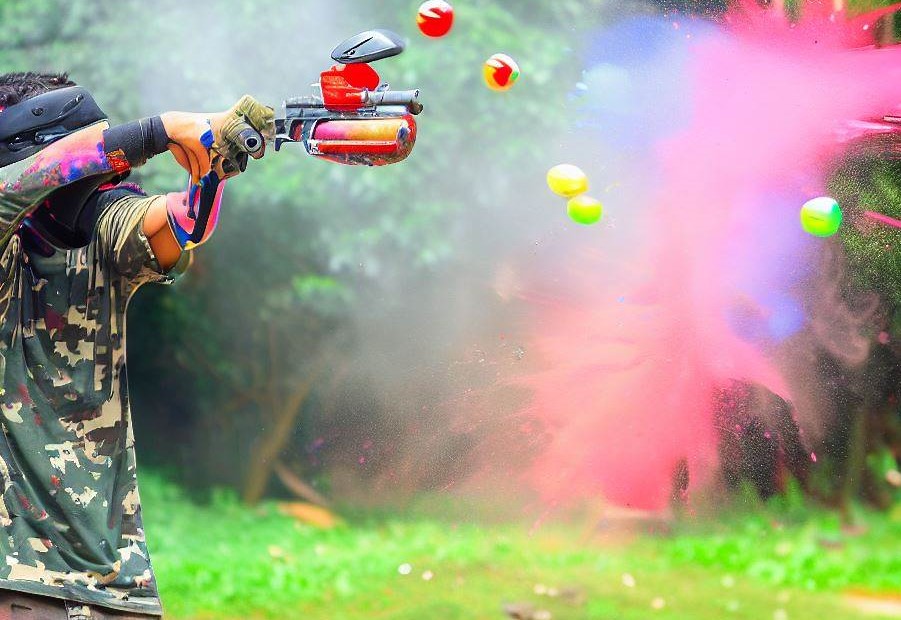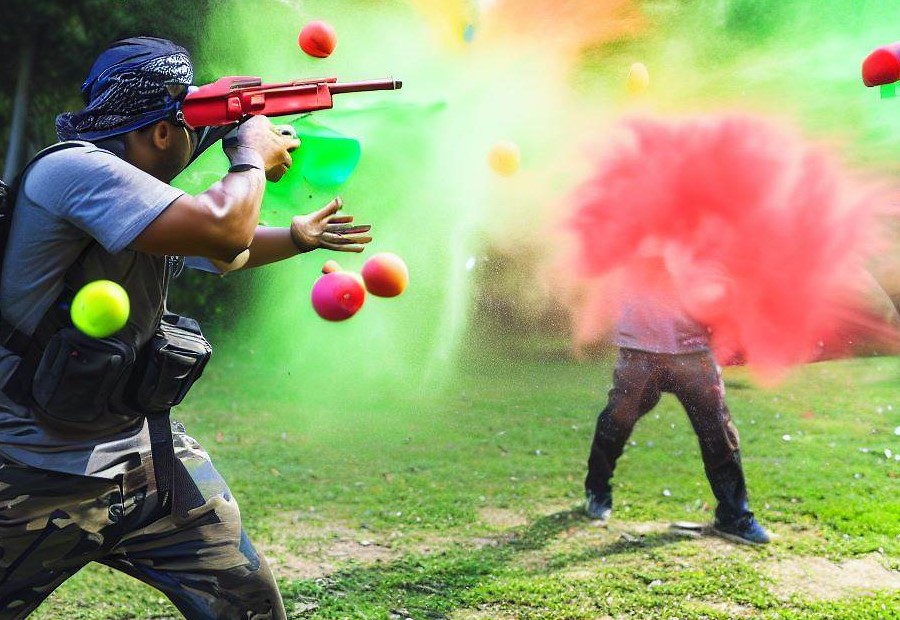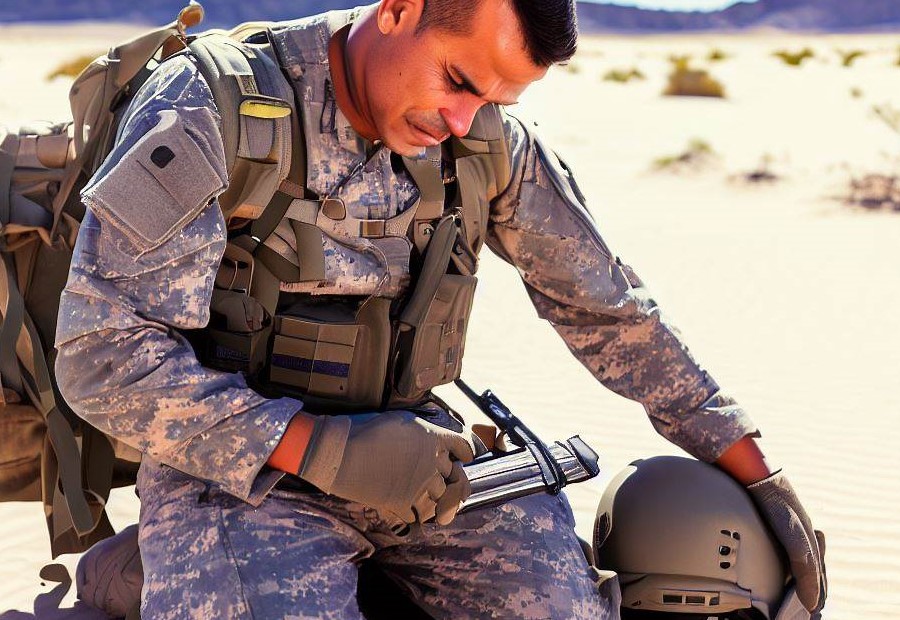Paintball is a thrilling and popular activity that involves shooting opponents with paint-filled projectiles. While it provides an exciting and competitive experience, it is important to consider the potential for injuries that can occur during gameplay. Understanding the common paintball injuries, their prevalence, and the factors contributing to these injuries is crucial for ensuring safety and implementing necessary precautions.
Paintball injuries encompass a range of physical harm that can result from direct hits or accidental falls during gameplay. These injuries can vary from minor bruises to more serious conditions such as eye injuries, head injuries, broken bones, sprains, strains, and even heat-related illnesses. It is essential to be aware of these potential risks to promote a safe and enjoyable paintball experience.
In terms of how common paintball injuries are, statistics play a significant role in shedding light on the prevalence of such incidents. Gathering data on paintball injuries can help identify trends, risk factors, and strategies for injury prevention.
Various factors contribute to paintball injuries, including the lack of proper protective gear, noncompliance with safety rules, and inadequate training. Addressing these factors is essential for minimizing the occurrence and severity of paintball-related injuries.
To ensure a safe and enjoyable paintball experience, players should adhere to important safety guidelines and receive proper training on handling equipment and gameplay tactics. Wearing appropriate protective gear, following safety guidelines, and receiving adequate training are essential steps for injury prevention.
By understanding the nature of paintball injuries, their prevalence, and the factors contributing to their occurrence, players can take proactive measures to reduce the risk of harm and promote a safer paintball environment.
What are Paintball Injuries?

Paintball injuries can range from minor bruises to more serious, although rare, injuries. If you’re wondering, “What are paintball injuries?“, here is a list of common paintball injuries:
- Minor bruises: It is common to experience bruising from getting hit by a paintball. These bruises are typically superficial and heal on their own.
- Abrasions: Paintball impacts can cause abrasions or scrapes on the skin. These injuries are usually minor and can be treated with proper cleaning and bandaging.
- Eye injuries: Eye injuries are a significant concern in paintball. It is crucial to wear appropriate eye protection to prevent serious eye damage. Paintballs can cause corneal abrasions or even more severe injuries like retinal detachment.
- Sprains and strains: Quick, sudden movements in the game can lead to sprains or strains, particularly in the ankles, wrists, and knees. These injuries may require rest, icing, compression, and elevation to heal properly.
- Fractures: While fractures are relatively uncommon, they can occur from falls, collisions, or impacts with obstacles during the game. Fractures may require medical attention, including immobilization and potential surgery.
So, what are paintball injuries? They are injuries that can occur while playing paintball. It’s important to note that proper safety measures, such as wearing appropriate protective gear, following the rules of the game, and practicing good sportsmanship, can significantly reduce the risk of paintball injuries. Stay safe and have fun!
How Common are Paintball Injuries?
Curious about the frequency of paintball injuries? Let’s take a dive into the world of paintball injury statistics. Get ready to uncover surprising facts and figures that shed light on just how common these injuries really are. Brace yourself for a riveting exploration into the realm of paintball accidents and discover the reality behind the adrenaline-fueled sport.
Paintball Injury Statistics
Below is a table highlighting some paintball injury statistics:
| Type of Injury | Percentage of Paintball Injuries |
|---|---|
| Bruises and Contusions | 45% |
| Eye Injuries | 20% |
| Head Injuries | 15% |
| Broken Bones | 10% |
| Sprains and Strains | 5% |
| Heat-Related Illnesses | 5% |
Paintball injury statistics highlight the prevalence and distribution of injuries in the sport. The provided table showcases the types of injuries and their corresponding percentages among paintball players. In particular, bruises and contusions account for the highest percentage, with 45% of all paintball injuries.
Meanwhile, eye injuries constitute 20% of the total, while head injuries make up 15%. Broken bones represent 10% of the injuries, while sprains and strains, as well as heat-related illnesses, each contribute 5% to the overall injury statistics.
These figures underscore the need for players to prioritize safety by utilizing appropriate protective gear and following established guidelines. By doing so, the risk of paintball injuries can be significantly reduced.
Types of Paintball Injuries

Discovering the various types of paintball injuries is like diving into a battlefield of bumps, bruises, and broken bones. From eye injuries that make you see stars to head injuries that leave you dazed, we’ll explore the thrilling yet perilous world of paintball injuries. So gear up and brace yourself as we unravel the bruises and contusions, the bone-breaking aftermath, and the consequences of noncompliance with safety rules. It’s time to learn about the not-so-pleasant side of this adrenaline-fueled sport.
Bruises and Contusions
Bruises and contusions are frequent injuries in the sport of paintball. These occur when a player takes a hit from a paintball, resulting in a localized area of discoloration and tenderness on the skin. The impact from the paintball can cause blood vessels to break, leading to the characteristic bruising.
The severity of these bruises and contusions can vary. Some may be minor, causing only slight discomfort and fading quickly, while others can be more severe, causing significant pain and taking longer to heal.
To prevent bruises and contusions, players should prioritize wearing appropriate protective gear, which includes a helmet, goggles, and padding for vulnerable areas such as the chest and arms. It is also crucial to adhere to safety guidelines and rules, such as maintaining a safe distance from other players and avoiding reckless behavior.
While bruises and contusions may be common in paintball, players can generally avoid or minimize them by taking proper precautions. It is essential for paintball players to prioritize safety and take all necessary measures to protect themselves during gameplay.
Fun Fact: The word “contusion” is derived from the Latin word “contusio,” which means “a bruising.”
Eye Injuries
Eye injuries are a significant concern in the sport of paintball, and it is crucial to take measures to protect your eyes while playing. Here are some key points to consider:
- Wear appropriate eye protection: When participating in paintball, it is important to wear proper protective eyewear designed specifically for paintball. This eyewear should have lenses that meet safety standards and provide full coverage for the eyes to minimize the risk of eye injuries.
- Ensure a proper fit: It is essential that the eyewear fits securely and comfortably to prevent any gaps that could allow paintballs or debris to enter the eye area and cause potential eye injuries.
- Regularly inspect and maintain eyewear: Before each game, it is important to inspect your goggles or masks to ensure there are no cracks or any other damage that could compromise their effectiveness. Additionally, it is necessary to clean them regularly according to the manufacturer’s instructions to maintain their functionality.
- Adhere to safety rules: To minimize the risk of eye injuries, it is crucial to follow all safety rules and guidelines provided by the paintball facility or organizers. It is essential to never remove your eyewear during gameplay and to never intentionally shoot at someone’s face or head.
- Respond promptly to any eye injury: In the unfortunate event of an eye injury, it is imperative to seek immediate medical attention. Even seemingly minor injuries can have serious consequences if left untreated, so it is crucial to respond promptly.
By taking these precautions, you can significantly reduce the risk of eye injuries while enjoying the sport of paintball.
Head Injuries
Head injuries are a serious concern in paintball, as they can have significant consequences.
Direct impact to the head can result in concussions, which are brain injuries that can lead to symptoms such as headaches, dizziness, and confusion.
Head injuries can also cause skull fractures, which can be life-threatening and require immediate medical attention.
In some cases, head injuries can result in traumatic brain injuries, which can have long-term effects on cognition, memory, and overall brain function.
Protecting the head is crucial to prevent these injuries. Wearing a properly fitted helmet or paintball mask is essential. Head injuries can occur due to noncompliance with safety rules, such as removing the mask during gameplay or not wearing head protection.
To reduce the risk of head injuries, players should always follow safety guidelines and regulations set by the paintball facility. Receiving proper training on safe gameplay techniques and learning how to properly handle equipment can also help prevent head injuries.
Ultimately, preventing head injuries in paintball requires a combination of protective gear, adherence to safety rules, and proper training.
Broken Bones
Broken bones are a common type of injury in paintball. When players fall or collide with obstacles, they can experience fractures or breaks in their bones.
The most commonly affected bones are the arms, legs, and ribs. These injuries can result from high-impact falls, direct hits with paintballs, or collisions with other players.
The severity of broken bones can vary, ranging from hairline fractures to complete fractures requiring medical intervention.
Players should seek immediate medical attention if they suspect a broken bone.
Sprains and Strains
Sprains and strains are common injuries in paintball.
They occur when ligaments or muscles are stretched or torn due to sudden or excessive force.
Paintball involves a lot of running, jumping, and quick movements, which can put strain on the muscles and joints.
Sprains typically occur when the ligaments are twisted or overstretched, causing pain, swelling, and limited mobility.
Strains, on the other hand, happen when muscles or tendons are pulled or torn, resulting in similar symptoms.
The severity of sprains and strains can vary, ranging from mild discomfort to more severe pain and immobility.
Sprains and strains can be prevented by:
- Warming up and stretching before playing to prepare the muscles and joints.
- Using proper running and jumping techniques to avoid unnecessary strain.
- Wearing supportive footwear to provide stability and reduce the risk of twisting or rolling an ankle.
- Stopping play if you feel any pain or discomfort and seeking medical attention if necessary.
Remember, while paintball can be a fun and exciting activity, it’s essential to prioritize your safety to minimize the risk of injuries like sprains and strains. Stay active, stay safe!
Heat-Related Illnesses

The sub-topic “Heat-Related Illnesses” regarding paintball injuries can be expanded using a list of heat-related illnesses and their implications:
- Heat stroke: Heat stroke is a severe heat-related illness that occurs when the body’s temperature regulation fails, leading to a dangerous rise in body temperature. It can result in organ damage, confusion, seizures, and even death. Immediate medical attention is necessary if heat stroke is suspected.
- Heat exhaustion: Heat exhaustion is characterized by heavy sweating, dizziness, fatigue, nausea, and muscle cramps. It is a milder form of heat-related illness but still requires prompt treatment. If left untreated, it can progress to heat stroke.
- Heat cramps: Heat cramps are painful muscle contractions that are typically caused by electrolyte imbalances due to excessive sweating. Proper hydration and replenishment of electrolytes are crucial to prevent heat cramps.
- Dehydration: When the body loses more fluids than it takes in, dehydration occurs. In the context of paintball, dehydration can result from prolonged physical activity in a hot environment without sufficient water intake. It can lead to fatigue, dizziness, confusion, and reduced cognitive and physical performance.
Preventing heat-related illnesses during paintball activities is essential. Players should:
- Stay hydrated: Drink plenty of water before, during, and after playing to maintain proper hydration levels and replace fluids lost through sweating.
- Take breaks in shaded areas: Seek shelter from the sun during breaks to cool down and prevent overheating.
- Wear lightweight and breathable clothing: Choose clothing that allows sweat to evaporate and helps in regulating body temperature.
- Use sunscreen: Apply sunscreen to protect your skin from sunburn, which can exacerbate the risk of heat-related illnesses.
- Listen to your body: Pay attention to signs of overheating, such as excessive sweating, dizziness, or fatigue, and take immediate measures to cool down.
By following these precautions, players can minimize the risk of heat-related illnesses and enjoy a safer paintball experience.
Lack of Protective Gear

Photo Credits: Paintballbuzz.Com by Bradley Allen
When it comes to paintball, lack of protective gear such as a mask, chest protector, neck protector, gloves, and knee and elbow pads can significantly increase the risk of injuries. It is important to prioritize safety and ensure that all necessary gear is worn during play.
- Mask: Wearing a full-face mask is essential to protect the eyes, face, and ears from paintball impacts. Without a mask, there is a high risk of serious eye injuries.
- Chest protector: A chest protector helps protect vital organs, ribs, and reduces the impact of paintball hits to the torso.
- Neck protector: A neck protector provides added safety by shielding the vulnerable neck area.
- Gloves: Wearing gloves protects the hands and fingers from direct impact and prevents painful injuries.
- Knee and elbow pads: These protective pads help cushion falls and prevent injuries to the joints.
Ensuring the availability and use of proper protective gear is crucial for minimizing the risk of paintball injuries due to lack of protective gear. By following these safety precautions and using the right equipment, players can enjoy the sport while reducing the likelihood of harm.
Noncompliance with Safety Rules
Noncompliance with safety rules is a major contributor to paintball injuries. It is crucial to follow safety guidelines to ensure a safe and enjoyable experience.
- Wear proper protective gear: Wearing appropriate protective gear such as helmets, masks, goggles, and padding can significantly reduce the risk of injuries. These items are designed to protect vulnerable areas of the body from impacts.
- Adhere to safety guidelines: Following safety guidelines such as maintaining a safe distance from other players, not removing protective gear during gameplay, and avoiding dangerous maneuvers can prevent accidents and minimize the risk of injuries.
- Receive proper training: Proper training in the rules and techniques of paintball can enhance player proficiency and ensure that players understand how to play the game safely. Training should include instruction on proper gun handling, target shooting, and safety protocols.
By adhering to safety rules and taking the necessary precautions, players can minimize the risk of paintball injuries and enjoy the game safely. Remember, the primary goal is to have fun while playing within safe boundaries.
Inadequate Training
Inadequate training is one of the key factors that contribute to paintball injuries. To ensure safety and minimize risks during paintball games, it is absolutely crucial for players to undergo proper training. Here are some actionable steps that can address the issue of inadequate training:
- Enroll in a reputable paintball facility that offers comprehensive and structured training programs.
- Participate in specialized training sessions specifically tailored for paintball players.
- Acquire a strong understanding of the rules, regulations, safety guidelines, and procedures associated with paintball.
- Take advantage of educational sessions or workshops that focus on teaching proper paintball techniques and strategies.
- Regularly practice improving skills and become more familiar with the equipment used in paintball.
- Seek guidance and mentorship from experienced players or certified instructors to enhance proficiency.
- Stay updated with the latest safety protocols and recommendations provided by reliable sources.
By diligently following these steps and placing a high priority on proper training, paintball players can significantly reduce the risk of injuries and create a much safer environment for everyone involved.
Frequently Asked Questions
Are paintball injuries common?
Yes, paintball injuries are common. According to paintball accident statistics, there are an average of 56 emergency room visits related to paintball injuries every day in the United States.
What are the most common paintball injuries?
The most common paintball injuries include eye injuries, ear injuries, head and neck injuries, exposed skin injuries, and sprained or twisted ankles.
How can paintball injuries be prevented?
To prevent paintball injuries, it is important to follow key safety practices such as having qualified referees overseeing games, supplying ANSI-approved safety goggles and other protective equipment, enforcing the use of proper footwear, and posting clear signage to mark boundary areas and safety zones.
What are the risks of traumatic eye injuries in paintball?
The high velocity of the paintball pellets can cause traumatic eye injuries, including cornea scratches, detached retinas, and even permanent vision loss. Wearing protective facial masks, such as the Bolle Cobra safety goggles, is advised but may not always prevent eye injuries.
Can paintball matches result in brain injuries?
Yes, paintball matches can result in brain injuries. Head impacts from paintball pellets or falls can cause concussions, brain hemorrhaging, skull fractures, and other serious brain injuries. Wearing helmets or masks that offer full head protection is crucial to prevent these injuries.
What are the risks of ear injuries in paintball?
Ear injuries are common in paintball and can result in cauliflower ear, ruptured eardrums, and even permanent hearing loss. Wearing a helmet or mask that covers the ears, such as the Empire Helix thermal mask, can help prevent minor ear injuries from becoming more serious.

